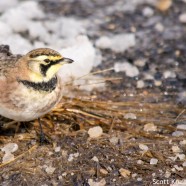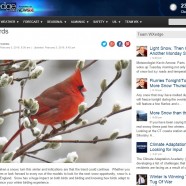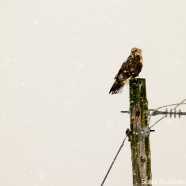Horned Lark in Road
After not seeing Horned Larks much at all this winter I have been spotting plenty lately! The frequent heavy snow and February depth of well over a foot has pushed them out into the open, feeding on the side of roads like this one. This weekend I will post a blog entry with many more photos of the species that we all wish we saw more of during the breeding season. Scott Kruitbosch Conservation & Outreach Coordinator
Read MoreWinter Bird Forecast #5 – Snow Birds
The latest Winter Bird Forecast from Audubon Connecticut and the Roger Tory Peterson Institute of Natural History is up at WXedge.com and features snow birds of all sorts in this suddenly snowy winter season. We discuss how snow impacts the birds and birding and what can be seen during such a stormy stretch.
Read MoreRough-legged Hawks Irrupting
This is a companion blog entry to the Winter Bird Forecast by Audubon Connecticut and the Roger Tory Peterson Institute of Natural History. Be sure to watch for our fifth forecast, coming soon! Wherever you are across the Northeast you have likely seen or read a report about a Rough-legged Hawk nearby this winter. This beautiful raptor, available in both a light and dark color morph, has irrupted across a broad swath of the upper parts of the Lower 48. The wintering specialty is at home in open and coastal areas such as marshes, grasslands, airports – hey, a lot of the same places the...
Read MoreInsects and the Diseases They Can Cause
“Insects and the Diseases They Can Cause” Jamie Haight from the New York State Health Department – February 26, 2015 Jamie, a biologist for the New York State Health Department, does disease surveillance and mosquito and tick investigation in western New York. He will present a program on “Insects and the Diseases They Can Cause” on Thursday, February 26, 2015 at 6:00PM here at RTPI. See more information on our Speaker Series page. This event is free and open to the public.
Read MoreGroundhog (Marmota monax) by Scott Kruitbosch
Tomorrow is Groundhog (Marmota monax) Day! We all know the basics – if the groundhog sees his shadow that means we have six more weeks of winter and if he does not we will have an early spring. While bearing in mind these rodents don’t have meteorological degrees and cannot move the sun to change our seasons it seems that the basic historical notion is rooted in weather observation. If the sun is shining we are likely under high pressure continuing cold or average temperatures and dry conditions, like much of what we had recently. Clouds obscuring the sun entirely are often due...
Read More








